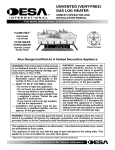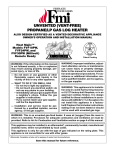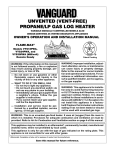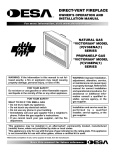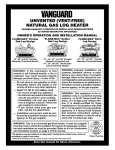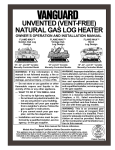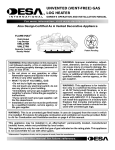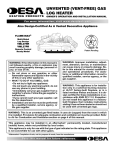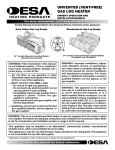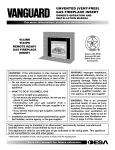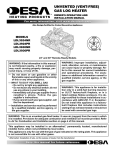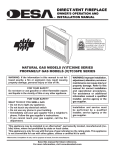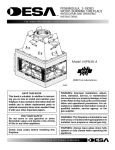Download Desa VTD-18N-PDG User's Manual
Transcript
GAS LOG VENTED DECORATIVE APPLIANCE OWNER’S OPERATION AND INSTALLATION MANUAL For more information, visit www.desatech.com VTD-24N-PDG, VTD-24P-PDG, VTD-18N-PDG, VTD-18P-PDG ANSI Z21.60-2003 CSA 2.26-2003 VTD-24N-BTB, VTD-24P-BTB, VTD-18N-BTB, VTD-18P-BTB APPROVED WARNING: If the information in this manual is not followed exactly, a fire or explosion may result causing property damage, personal injury, or loss of life. — Do not store or use gasoline or other flammable vapors and liquids in the vicinity of this or any other appliance. — WHAT TO DO IF YOU SMELL GAS • Do not try to light any appliance. • Do not touch any electrical switch; do not use any phone in your building. • Immediately call your gas supplier from a neighbor’s phone. Follow the gas supplier’s instructions. • If you cannot reach your gas supplier, call the fire department. — Installation and service must be performed by a qualified installer, service agency, or the gas supplier. WARNING: Improper installation, adjustment, alteration, service, or maintenance can cause injury or property dam age. Re fer to this man u al for correct installation and operational procedures. For assistance or additional information consult a qualified installer, service agency, or the gas supplier. WARNING: This appliance is for installation only in a solid-fuel burning masonry or UL127 factory-built fireplace, constructed of noncombustible material, and connected to a working flue. (See page 7 for minimum flue opening.) WARNING: This is a gas-fired appliance. It uses air (oxygen) from the room in which it is installed. Provisions for adequate combustion and ventilation air must be provided. Refer to the National Fuel Gas Codes, ANSI Z233.1/NFPA 54, Section 5.3, Air for Combustion and Ventilation. This appliance may be installed in an aftermarket,* manufactured (mobile) home, where not prohibited by local codes. This appliance is only for use with the type of gas indicated on the rating plate. This appliance is not convertible for use with other gases. Warning: This product must be installed by a Licensed Plumber or Gas Fitter when installed within The Commonwealth of Massachusetts. * Aftermarket: Completion of sale, not for purpose of resale, from the manufacturer Save this manual for future reference. 2 TABLE OF CONTENTS SAFETY INFORMATION TABLE OF CONTENTS SAFETY INFORMATION..............................................................2 CLEANING AND MAINTENANCE .............................................13 LOCAL CODES ............................................................................3 TROUBLESHOOTING................................................................14 PRODUCT IDENTIFICATION.......................................................3 REPLACEMENT PARTS ............................................................18 UNPACKING.................................................................................4 ILLUSTRATED PARTS BREAKDOWN AND PARTS LIST .........20 PRODUCT FEATURE ..................................................................4 ACCESSORIES..........................................................................22 INSTALLATION ............................................................................7 OWNER'S REGISTRATION FORM............................................23 OPERATING APPLIANCE..........................................................11 WARRANTY INFORMATION ...................................... Back Cover INSPECTING BURNERS ..........................................................13 SAFETY INFORMATION WARNING ICON G 001 WARNINGS WARNING: Keep flue open when operating unit. IMPORTANT: Read this owner’s manual carefully and completely before trying to assemble, operate, or service this log set. Improper use of this log set can cause serious injury or death from burns, fire, explosion, electrical shock, and carbon monoxide poisoning. DANGER: Carbon monoxide poisoning may lead to death! WARNING:This product contains and/or generates chemicals known to the State of California to cause cancer or birth defects, or other reproductive harm. Carbon Monoxide Poisoning: Early signs of carbon monoxide poisoning resemble the flu, with headaches, dizziness, or nausea. If you have these signs, the log set may not be working properly. Get fresh air at once! Have log set serviced. Some people are more affected by carbon monoxide than others. These include pregnant women, people with heart or lung disease or anemia, those under the influence of alcohol, and those at high altitudes. Natural & LP Gas : Natural & LP gas are odorless. An odor-mak- ing agent is added to the gas. The odor helps you detect a gas leak. However, the odor added to the gas can fade. Gas may be present even though no odor exists. Make certain you read and understand all warnings. Keep this manual for reference. It is your guide to safe and proper operation of this log set. WARNING: Any change to this log set or its controls can be dangerous. 1. 2. This appliance, as supplied, is only for use with the type of gas indicated on the rating plate. If you smell gas • shut off gas supply • do not try to light any appliance • do not touch any electrical switch; do not use any phone in your building • immediately call your gas supplier from a neighbor’s phone. Follow the gas supplier’s instructions • if you cannot reach your gas supplier, call the fire department 3. Never install the log set • in a recreational vehicle • where curtains, furniture, clothing, or other flammable objects are less than 42 inches from the front, top, or sides of the log set • in high traffic areas • in windy or drafty areas 4. Before installing in a solid fuel burning fireplace, the chimney flue and firebox must be cleaned of soot, creosote, ashes and loose paint by a qualified chimney cleaner. Creosote will ignite if highly heated. Inspect chimney flue for damage. If damaged, repair flue before operating appliance. 5. You must operate this log set with fireplace doors or screens in place and fully closed. Unless provided by other means, screens shall have openings for introduction of combustion air. 6. This log set is designed to be smokeless. If logs ever appear to smoke, turn off appliance and call a qualified service person. Note: During initial operation, slight smoking could occur due to log curing and the burning of manufacturing residues. You may wish to add more ventilation by opening a window. 7. To reduce the creation of soot, follow the instructions in Cleaning and Maintenance, page 13. 8. Do not allow fans to blow directly into the fireplace. Avoid any drafts that alter burner flame patterns. Ceiling fans can create drafts that alter burner flame patterns. Altered burner patterns can increase sooting. 9. Do not use a blower insert, heat exchanger insert or other accessory not approved for use with this log set. 10. The installation and provisions for combustion and ventilation air must conform with the National Fuel Gas Codes, ANSI Z233.1/ NFPA 54, Section 5.3, Air for Combustion and Ventilation. 11. Do not run log set • where flammable liquids or vapors are used or stored • under dusty conditions For more information, visit www.desatech.com 111826-02F SAFETY INFORMATION LOCAL CODES PRODUCT IDENTIFICATION 3 3 SAFETY INFORMATION Continued 12. Do not burn solid fuel in the fireplace after installing the log set. Do not use this log set to cook food or burn paper or other objects. 13. Log set becomes very hot when in use. Keep children and adults away from hot surface to avoid burns or clothing ignition. Log set will remain hot for a time after shutdown. Allow surface to cool before touching. 14. Carefully supervise young children when they are in the room with log set. 15. Do not use this appliance if any part has been under water. Immediately call a qualified service technician to inspect the appliance and to replace any part of the control system and any gas control which has been under water. 17. Turn log set off and let cool before servicing, installing, or repairing. Only a qualified service person should install, service, or repair log set. 18. Keep the appliance area clear and free from combustible materials, gasoline and other flammable vapors and liquids. 19. Provide adequate clearances around air openings. WARNING: Do not place log scraps or lava rocks on burner. LOCAL CODES Install and use appliance with care. Follow all local codes. In the absence of local codes, use the latest edition of The National Fuel Gas Code ANSI Z223.1/NFPA 54*. *Available from: American National Standards Institute, Inc. 1430 Broadway New York, NY 10018 National Fire Protection Association, Inc. Batterymarch Park Quincy, MA 02269 PRODUCT IDENTIFICATION Log Set Lava Rock WARNING: Any change to this log set or its controls can be dangerous. WARNING: Do not use a blower insert, heat exchanger insert, or other accessory not approved for use with this appliance. Piezo Ignitor Control Knobs Log Scraps Chassis Assembly REMOTE READY MODELS WARNING: Keep flue open when operating unit. Appliance base assembly becomes very hot when running appliance. Keep children and adults away from hot surface to avoid burns or clothing ignition. Appliance will remain hot for a time after shutdown. Allow surface to cool before touching. Carefully supervise young children when they are in the room with appliance. When using the hand-held remote accessory (Remote-Ready Models Only), keep selector switch in the OFF position to prevent children from turning on burners with remote. You must operate this appliance with a fireplace screen in place. Make sure fireplace screen is closed before running appliance. Keep the appliance area clear and free from combustible materials, gasoline, and other flammable vapors and liquids. Log Set Lava Rock Piezo Ignitor Remote Control Remote Reciever Control Knobs REMOTE CONTROLLED MODELS Figure 1 - Product Identification For more information, visit www.desatech.com 111826-02F Chassis Assembly Log Scraps 4 OPTIONAL REMOTE CONTROL ACCESSORIES UNPACKING PRODUCT FEATURES AIR FOR COMBUSTION AND VENTILATION Providing Adequate Ventilation OPTIONAL REMOTE CONTROL ACCESSORIES There are two optional remote controls that can be purchased separately for Remote-Ready Models: • wall switch • hand-held ON/OFF remote See Accessories, page 22. The wall thermostat or hand-held thermostat may not be used with vented decorative appliances. UNPACKING CAUTION: Do not remove the data plates from the grate assembly. The data plates contain important warranty and safety information. 1. 2. 3. 4. Remove log set assembly from carton. Note: Do not pick up assembly by logs. This could damage the unit. Always handle assembly by grate. Remove control cover floor media components & remote control if supplied. Remove all protective packaging applied to log set for shipment. Check all items for any shipping damage. If damaged, promptly inform dealer where you bought appliance. PRODUCT FEATURES REMOTE READY & REMOTE CONTROLLED This unitized gas log set is tested and approved to ANSI Z21.60a and CSA 2.26a-2000 as a vented decorative appliance. This log set has a piezo ignitor . This system requires no matches, batteries or other source to light log set. SAFETY DEVICE This unit has a pilot with an Oxygen Depletion Sensing (ODS) safety shutoff system. The ODS/pilot shuts off the appliance if there is not enough fresh air. PIEZO IGNITION SYSTEM This unit has a piezo ignitor. This system requires no matches, batteries, or other sources to light appliance. AIR FOR COMBUSTION AND VENTILATION WARNING: This appliance shall not be installed in a confined space or unusually tight construction unless provisions are provided for adequate combustion and ventilation air. Read the following instructions to insure proper fresh air for this and other fuel-burning appliances in your home. Today’s homes are built more energy efficient than ever. New materials, increased insulation, and new construction methods help reduce heat loss in homes. Home owners weather strip and caulk around windows and doors to keep the cold air out and the warm air in. During heating months, home owners want their homes as airtight as possible. While it is good to make your home energy efficient, your home needs to breathe. Fresh air must enter your home. All fuel-burning appliances need fresh air for proper combustion and ventilation. Exhaust fans, fireplaces, clothes dryers, and fuel burning appliances draw air from the house to operate. You must provide adequate fresh air for these appliances. This will insure proper venting of vented fuel-burning appliances. PROVIDING ADEQUATE VENTILATION The following are excerpts from National Fuel Gas Code, ANSI Z223.1/NFPA 54, Section 5.3, Air for Combustion and Ventilation. All spaces in homes fall into one of the three following ventilation classifications: 1. Unusually Tight Construction 2. Unconfined Space 3. Confined Space The information on pages 4 through 6 will help you classify your space and provide adequate ventilation. Unusually Tight Construction The air that leaks around doors and windows may provide enough fresh air for combustion and ventilation. However, in buildings of unusually tight construction, you must provide additional fresh air. Unusually tight construction is defined as construction where: a. walls and ceilings exposed to the outside atmosphere have a continuous water vapor retarder with a rating of one perm (6 x 10-11 kg per pa-sec-m2) or less with openings gasketed or sealed and b. weather stripping has been added on openable windows and doors and c. caulking or sealants are applied to areas such as joints around window and door frames, between sole plates and floors, between wall-ceiling joints, between wall panels, at penetrations for plumbing, electrical, and gas lines, and at other openings. If your home meets all of the three criteria above, you must provide additional fresh air. See Ventilation Air From Outdoors, page 5. If your home does not meet all of the three criteria above, proceed to Determining Fresh-Air Flow For Appliance Location, below. For more information, visit www.desatech.com 111826-02F AIR FOR COMBUSTION AND VENTILATION Providing Adequate Ventilation (Cont.) Determining Fresh-Air Flow for Appliance Location Ventilation Air AIR FOR COMBUSTION AND VENTILATION Continued Confined and Unconfined Space The National Fuel Gas Code, ANSI Z223.1/NFPA 54 defines a confined space as a space whose volume is less than 50 cubic feet per 1,000 Btu per hour (4.8 m3 per kw) of the aggregate input rating of all appliances installed in that space and an unconfined space as a space whose volume is not less than 50 cubic feet per 1,000 Btu per hour (4.8 m3 per kw) of the aggregate input rating of all appliances installed in that space. Rooms communicating directly with the space in which the appliances are installed*, through openings not furnished with doors, are considered a part of the unconfined space. * Adjoining rooms are communicating only if there are doorless passageways or ventilation grills between them. DETERMINING FRESH-AIR FLOW FOR APPLIANCE LOCATION Determining if You Have a Confined or Unconfined Space Use this work sheet to determine if you have a confined or unconfined space. Space: Includes the room in which you will install appliance plus any adjoining rooms with doorless passageways or ventilation grills between the rooms. 1. Determine the volume of the space (length x width x height). Length x Width x Height = ____________cu. ft. (volume of space) Example: Space size 20 ft. (length) x 16 ft. (width) x 8 ft. (ceiling height) = 2560 cu. ft. (volume of space) If additional ventilation to adjoining room is supplied with grills or openings, add the volume of these rooms to the total volume of the space. 2. Multiply the space volume by 20 to determine the maximum Btu/Hr the space can support. ____________(volume of space) x 20 = (Maximum Btu/Hr the space can support) Example: 2560 cu. ft. (volume of space) x 20 = 51,200 (maximum Btu/Hr the space can support) 3. Add the Btu/Hr of all fuel burning appliances in the space. Vent-free appliance _____________ Btu/Hr Gas water appliance* _____________ Btu/Hr Gas furnace _____________ Btu/Hr Vented gas appliance _____________ Btu/Hr Gas fireplace logs _____________ Btu/Hr Other gas appliances* + _____________ Btu/Hr Total = _____________ Btu/Hr * Do not include direct-vent gas appliances. Direct-vent draws combustion air from the outdoors and vents to the outdoors. Example: 40,000 Gas water appliance _____________ Btu/Hr 33,000 Vent-free appliance + _____________ Btu/Hr 73,000 Total = _____________ Btu/Hr 4. Compare the maximum Btu/Hr the space can support with the actual amount of Btu/Hr used. ____________________Btu/Hr (maximum the space can support) ____________________Btu/Hr (actual amount of Btu/Hr used) Example: 51,200 Btu/Hr (maximum the space can support) 73,000 Btu/Hr (actual amount of Btu/Hr used) The space in the above example is a confined space because the actual Btu/Hr used is more than the maximum Btu/Hr the space can support. You must provide additional fresh air. Your options are as follows: A. Rework worksheet, adding the space of an adjoining room. If the extra space provides an unconfined space, remove door to adjoining room or add ventilation grills between rooms. See Ventilation Air From Inside Building, page 6. B. Vent room directly to the outdoors. See Ventilation Air From Outdoors, page 6. C. Install a lower Btu/Hr appliance, if lower Btu/Hr size makes room unconfined. If the actual Btu/Hr used is less than the maximum Btu/Hr the space can support, the space is an unconfined space. You will need no additional fresh air ventilation. WARNING: If the area in which the appliance may be operated is smaller than that defined as an unconfined space or if the building is of unusually tight construction, provide adequate combustion and ventilation air by one of the methods described in the National Fuel Gas Code, ANSI Z223.1/NFPA 54 Section 5.3 or applicable local codes. VENTILATION AIR Ventilation Air From Inside Building This fresh air would come from an adjoining unconfined space. When ventilating to an adjoining unconfined space, you must provide two permanent openings: one within 12" of the ceiling and one within 12" of the floor on the wall connecting the two spaces (see options 1 and 2, Figure 2). You can also remove door into adjoining room (see option 3, Figure 2). Follow the National Fuel Gas Code, ANSI Z223.1/NFPA 54, Section 5.3, Air for Combustion and Ventilation for required size of ventilation grills or ducts. Ventilation Air From Outdoors Provide extra fresh air by using ventilation grills or ducts. You must provide two permanent openings: one within 12" of the ceiling and one within 12" of the floor. Connect these items directly to For more information, visit www.desatech.com 111826-02F 5 5 6 AIR FOR COMBUSTION AND VENTILATION Ventilation Air (Cont.) AIR FOR COMBUSTION AND VENTILATION Continued the outdoors or spaces open to the outdoors. These spaces include attics and crawl spaces. Follow the National Fuel Gas Code, ANSI Z223.1/NFPA 54, Section 5.3, Air for Combustion and Ventilation for required size of ventilation grills or ducts. Outlet Air Ventilated Attic Outlet Air To Attic IMPORTANT: Do not provide openings for inlet or outlet air into attic if attic has a thermostat-controlled power vent. Heated air entering the attic will activate the power vent. To Crawl Space Inlet Air 12" Inlet Air Ventilation Grills Into Adjoining Room, Option 1 Ventilation Grills Into Adjoining Room, Option 2 Or Remove Door into Adjoining Room, Option 3 Ventilated Crawl Space Figure 3 - Ventilation Air from Outdoors 12" Figure 2 - Ventilation Air from Inside Building For more information, visit www.desatech.com 111826-02F INSTALLATION Flue Opening Specifications Installation and Clearances Venting Specifications for Installation Installing Damper Clamp INSTALLATION 7 7 INSTALLATION AND CLEARANCES WARNING: Before installing in a solid fuel burning fireplace, the chimney flue and firebox must be cleaned of soot, creosote, ashes and loose paint by a qualified chimney cleaner. Creosote will ignite if highly heated. A dirty chimney flue may create and distribute soot within the house. Inspect chimney flue for damage. If damaged, repair flue damper before operating appliance. LOG SIZING REQUIREMENTS Minimum Firebox Size Log Front Rear* Size Height Depth Width Width 18" 17" 14" 24" 20" 24" 17" 14" 28" 22" Min. Flue size 8" 8" *Measured at 14" depth WARNING: Make sure the selector switch is in the OFF position before installing appliance . WARNING: Before installing in a solid fuel burning fireplace, the chimney flue and firebox must be cleaned of soot, creosote, ashes and loose paint by a qualified chimney cleaner. Creosote will ignite if highly heated. A dirty chimney flue may create and distribute soot within the house. Inspect chimney flue for damage. NOTICE: Installation, service, and repair of this appliance must be performed by a qualified installer, service agency, company or gas supplier experienced with this type of gas appliance. Only factory authorized components listed in these instructions may be used in accordance with the manufacturer’s instructions and all codes and requirements of the authority having jurisdiction. Any modifications to this kit, or use of unauthorized components or accessory items will void the manufacturer’s warranty, and may result in a hazardous condition. FLUE OPENING SPECIFICATIONS Note: This vented appliance must be installed only in a solid-fuel burning fireplace with a working flue and constructed of noncombustible material. The charts in Figure 4 indicate technical information regarding the installation of your gas log set. Please make sure that all of the specifications shown are applicable before installation is attempted. Figure 5 - Sizes & Clearances CHECK GAS TYPE Use the correct gas type (natural or propane/LP) for your unit. If your gas supply is not correct, do not instal in fireplace. Call dealer where you bought the appliance for proper type of appliance. VENTING SPECIFICATIONS FOR INSTALLATION The fireplace chimney flue and vent must be drafting properly. To check the vent for proper drafting: Light a tightly rolled newspaper on one end and place it at the inside front edge of the fireplace. Observe the smoke and be sure the vent is properly drawing it up the chimney. If the smoke spills out into the room, extinguish the flame and remove any obstruction until proper venting is achieved. The chimney flue damper must be fixed open to provide a minimum of 43 sq. in. of free air opening during operation of this log set. A multipurpose damper clamp is provided to fix the damper in position. The minimum flue sizes shown in Figure 5 are based on a 6' chimney height using round pipe. Your minimum flue size will vary based on input rate and chimney height. Refer to the National Fuel Gas Code ANSI Z223.1/NFPA 54, Section 6.6, for details. INSTALLING DAMPER CLAMP Secure the damper stop clamp provided to the leading edge of the damper as shown in Figure 6. If for any reason this clamp doesn't work on your fireplace, another suitable clamp or permanent stop must be installed, or the damper blade must be cut or removed. Damper Clamp The fireplace must include a working flue and venting system with the minimum openings shown in the Figure 5. SPECIFICATIONS (W.C.) FUEL INLET PRESSURE NG LP Min. 7 11 Max. 10.5 14 Figure 4 - Technical Information Charts Damper 3.5 10 Damper Clamp Damper MANIFOLD PRESSURE Masonry Fireplace Manufactured Fireplace Figure 6 - Attaching Damper Clamp For more information, visit www.desatech.com 111826-02F Damper 8 INSTALLATION Installing Appliance Assembly Connecting To Gas Supply CONNECTING TO GAS SUPPLY INSTALLATION Continued INSTALLING APPLIANCE ASSEMBLY WARNING: If installing in a sunken fireplace, special care is needed. You must raise the fireplace floor to allow access to appliance control panel. This will insure adequate air flow and guard against sooting. Raise fireplace floor with noncombustible material. Make sure material is secure. CAUTION: Do not pick up appliance assembly by logs. This could damage unit. Only handle assembly by grates. IMPORTANT: Make sure the appliance is level. If unit is not level, unit will not work properly. Installation Items Needed • control cover kit (provided with appliance) • approved flexible gas hose and fittings (provided with appliance) (if allowed by local codes) • sealant (resistant to propane/LP gas, not provided) Note: Install optional Hand-Held Remote Control Kit (see Accessories, page 22) before installing gas log appliance (Remote-Ready Models Only). See installation instructions included with the kit. 1. 2. 3. Apply pipe joint sealant lightly to male threads of gas fitting (not provided). Connect approved flexible gas hose to inlet side of gas control (see Figure 7). Position appliance in fireplace. Connect to gas supply. See Connecting To Gas Supply. Gas Control Flexible Gas Hose (if allowed by local codes) WARNING: This appliance requires a 3/8" NPT (National Pipe Thread) inlet connection to the pressure regulator. WARNING: A qualified service person must connect appliance to gas supply. Follow all local codes. CAUTION: Never connect propane/LP fireplace directly to the propane/LP supply. This unit requires an external regulator (not supplied). Install the external regulator between the unit and propane/LP supply. WARNING: Never connect natural gas fireplace to private (non-utility) gas wells. This gas is commonly known as wellhead gas. Installation Items Needed Before installing appliance, make sure you have the items listed below. • external regulator (supplied by installer) • piping (check local codes) • sealant (resistant to propane/LP gas) • equipment shutoff valve * • test gauge connection * • sediment trap • tee joint • pipe wrench • approved flexible gas line with gas connector (if allowed by local codes) (provided) * A CSA design-certified equipment shutoff valve with 1/8" NPT tap is an acceptable alternative to test gauge connection. Purchase the optional CSA design-certified equipment shutoff valve from your dealer. See Accessories, page 22. For propane/LP units, the installer must supply an external regulator. The external regulator will reduce incoming gas pressure. You must reduce incoming gas pressure to between 11 and 14 inches of water. If you do not reduce incoming gas pressure, regulator damage could occur. Install external regulator with the vent pointing down as shown in Figure 8 page 9. Pointing the vent down protects it from freezing rain or sleet. CAUTION: Use only new, black iron or steel pipe. Internally-tinned copper tubing may be used in certain areas. Check your local codes. Use pipe of 1/2" diameter or greater to allow proper gas volume to appliance. If pipe is too small, undue loss of volume will occur. Figure 7 - Attaching Flexible Gas Hose to Gas Regulator For more information, visit www.desatech.com 111826-02F INSTALLATION Connnecting to Gas Supply (cont.) Checking Gas Connections Pressure Testing Gas Supply Piping System INSTALLATION CSA Design-Certified Equipment Shutoff Valve With 1/8" NPT Tap* Continued Installation must include an equipment shutoff valve, union, and plugged 1/8" NPT tap. Locate NPT tap within reach for test gauge hook up. NPT tap must be upstream from appliance (see Figure 9). Approved Flexible Gas Hose (if allowed by local codes) IMPORTANT: Install equipment shutoff valve in an accessible location. The equipment shutoff valve is for turning on or shutting off the gas to the appliance. Pipe Cap Nipple Tee Joint Sediment Trap Figure 9 - Gas Connection * Purchase the optional CSA design-certified equipment shutoff valve from your dealer. See Accessories, page 22. **Minimum inlet pressure for purpose of input adjustment. CHECKING GAS CONNECTIONS WARNING: Test all gas piping and connections for leaks after installing or servicing. Correct all leaks at once. CAUTION: Avoid damage to gas control. Hold gas control with wrench when connecting it to gas piping and/or fittings. Installation must include an equipment shutoff valve, union, and plugged 1/8" NPT tap. Locate NPT tap within reach for test gauge hook up. NPT tap must be upstream from appliance (see Figure 9). WARNING: Never use an open flame to check for a leak. Apply a noncorrosive leak detection fluid to all joints. Bubbles forming show a leak. Correct all leaks at once. IMPORTANT: Install equipment shutoff valve in an accessible location. The equipment shutoff valve is for turning on or shutting off the gas to the appliance. CAUTION: Make sure external regulator has been installed between propane/LP supply and appliance. See guidelines under Connecting to Gas Supply, page 8. Apply pipe joint sealant lightly to male NPT threads. This will prevent excess sealant from going into pipe. Excess sealant in pipe could result in clogged appliance valves. External Regulator NATURAL - From Gas Meter (5" W.C.** to 10.5" W.C. Pressure) Gas Control WARNING: Use pipe joint sealant that is resistant to liquid petroleum (LP) gas. We recommend that you install a sediment trap in supply line as shown in Figure 9, depending on your model. Locate sediment trap where it is within reach for cleaning. Install in piping system between fuel supply and appliance. Locate sediment trap where trapped matter is not likely to freeze. A sediment trap traps moisture and contaminants. This keeps them from going into appliance controls. If sediment trap is not installed or is installed wrong, appliance may not run properly. PROPANE/LP - From External Regulator (11" W.C.** to 14" W.C. Pressure) 3" Minimum Apply pipe joint sealant lightly to male NPT threads. This will prevent excess sealant from going into pipe. Excess sealant in pipe could result in clogged appliance valves. 9 9 Pressure Testing gas Supply Piping system Test Pressures In Excess Of 1/2 PSIG (3.5 kPa) Propane/LP Supply Tank 1. 2. 3. Vent Pointing Down Figure 8 - External Regulator With Vent Pointing Down Disconnect appliance with its appliance main gas valve (control valve) and equipment shutoff valve from gas supply piping system. Pressures in excess of 1/2 psig will damage appliance regulator. Cap off open end of gas pipe where equipment shutoff valve was connected. Pressurize supply piping system by either opening propane/LP supply tank valve for propane/LP gas or opening main gas valve located on or near gas meter for natural gas, or using compressed air. For more information, visit www.desatech.com 111826-02F 10 INSTALLATION Pressure Testing Gas Supply Piping System (Cont.) Pressure Testing Appliance Gas Connections INSTALLATION Continued 4. 5. 6. Check all joints of gas supply piping system. Apply noncorrosive leak detection fluid to all joints. Bubbles forming show a leak. Correct all leaks at once. Reconnect appliance and equipment shutoff valve to gas supply. Check reconnected fittings for leaks. Equipment Shutoff Valve Propane/LP Supply Tank Control Valve Location Test Pressures Equal To or Less Than 1/2 PSIG (3.5 kPa) 1. 2. 3. 4. Close equipment shutoff valve (see Figure 10). Pressurize supply piping system by either opening propane/LP supply tank valve for propane/LP gas or opening main gas valve located on or near gas meter for natural gas, or using compressed air. Check all joints from gas meter to equipment shutoff valve for natural gas or propane/LP supply to equipment shutoff valve for propane/LP (see Figure 11). Apply noncorrosive leak detection fluid to all joints. Bubbles forming show a leak. Correct all leaks at once. Figure 11- Checking Gas Joints (propane/LP only) Pressure Testing Appliance Gas Connections 1. 2. 3. 4. 5. 6. 7. Open equipment shutoff valve (see Figure 10). Open main gas valve located on or near gas meter for natural gas or open propane/LP supply tank valve. Make sure control knob of appliance is in the OFF position. Check all joints from equipment shutoff valve to gas control (see Figures 11 and 12). Apply noncorrosive leak detection fluid to all joints. Bubbles forming show a leak. Correct all leaks at once. Light appliance (see Operating Appliance, pages 11 through 13). Check all other internal joints for leaks. Turn off appliance. Equipment Shutoff Valve ON POSITION Equipment Shutoff Valve Control Valve Location Gas Meter Open Figure 12 - Checking Gas Joints (Natural Gas Only) OFF POSITION Closed Figure 10 - Equipment Shutoff Valve For more information, visit www.desatech.com 111826-02F OPERATING APPLIANCE (REMOTE-READY MODELS) For Your Safety Read Before Lighting Lighting Instructions OPERATING APPLIANCE Selector Switch in OFF Position Control Knob REMOTE-READY MODELS LO OFF OT PIL ON FOR YOUR SAFETY READ BEFORE LIGHTING 11 11 HI AUTO OFF ON WARNING: Keep flue open when operating unit. WARNING: If you do not follow these instructions exactly, a fire or explosion may result causing property damage, personal injury or loss of life. A. This appliance has a pilot which must be lighted by hand. When lighting the pilot, follow these instructions exactly. B. BEFORE LIGHTING smell all around the appliance area for gas. Be sure to smell next to the floor because some gas is heavier than air and will settle on the floor. WHAT TO DO IF YOU SMELL GAS • Do not try to light any appliance. • Do not touch any electric switch; do not use any phone in your building. • Immediately call your gas supplier from a neighbor’s phone. Follow the gas supplier’s instructions. • If you cannot reach your gas supplier, call the fire department. C. Use only your hand to push in or turn the gas control knob. Never use tools. If the knob will not push in or turn by hand, don’t try to repair it, call a qualified service technician or gas supplier. Force or attempted repair may result in a fire or explosion. D. Do not use this appliance if any part has been under water. Immediately call a qualified service technician to inspect the appliance and to replace any part of the control system and any gas control which has been under water. LIGHTING INSTRUCTIONS Ignitor Button Flame Adjustment Knob Figure 13 - Control Knob and Ignitor Button Location, Remote Ready Units. 1. 2. 3. 4. WARNING: Burners will come on automatically within one minute when the selector switch is in the ON position after the pilot is lit. 5. 6. CAUTION: A mild gas flash may occur within 10 seconds of normal shutdown of this appliance. Remain clear of the hearth area for the entire shutdown process to avoid possible injury. Wait five (5) minutes to clear out any gas. Then smell for gas, including near the floor. If you smell gas, STOP! Follow “B” in the safety information, starting in column 1 of this page. If you don’t smell gas, go to the next step. Press in and turn control knob counterclockwise to the PILOT position. Press in control knob for five (5) seconds (see Figure 13). Note: You may be running this appliance for the first time after hooking up to gas supply. If so, the control knob may need to be pressed in for 30 seconds or more. This will allow air to bleed from the gas system. 7. With control knob pressed in, press and release ignitor button. This will light pilot. The pilot is attached to the front burner. If needed, keep pressing ignitor button until pilot lights. Note: If pilot does not stay lit, contact a qualified service person or gas supplier for repairs. Until repairs are made, light pilot with match. To light pilot with match, see Manual Lighting Procedure, page 12. 8. Keep control knob pressed in for 30 seconds after lighting pilot. After 30 seconds, release control knob. • If control knob does not pop out when released, contact a qualified service person or gas supplier for repairs. Note: If pilot goes out, repeat steps 4 through 8. NOTICE: During initial operation of new appliance, metallic components may emit an odor as paint and assembly compounds are heated and cure. Be sure to provide adequate fresh air if odors are detected. WARNING: Damper handle will be hot if appliance has been running. STOP! Read the safety information, starting in column 1, of this page. Make sure equipment shutoff valve is fully open. Set selector switch in the OFF position. to the Press in and turn control knob clockwise OFF position (see Figure 13). For more information, visit www.desatech.com 111826-02F OPERATING APPLIANCE (REMOTE-READY MODELS) Lighting Instructions (Cont.) Remote Control Operations 12 OPERATING APPLIANCE MANUAL LIGHTING PROCEDURE Continued 9. Slightly push in and turn control knob counterclockwise to the ON position. 10. Wait one minute and switch selector switch to the ON position to light burners. Note: AUTO is not functional. 11. Set flame adjustment knob to any level between HI and LO. 1. 2. 3. Follow steps 1 through 6 under Lighting Instructions. Depress control knob and light pilot with match. Keep control knob pressed in for 30 seconds after lighting pilot. After 30 seconds, release control knob. Now follow steps 9 through 11, Lighting Instructions, column 1. REMOTE CONTROL OPERATION Remote Control Operation CAUTION: Do not try to adjust heating levels by using the equipment shutoff valve. GHRC Series Operation: 1. WARNING: Make sure the selector switch is in the OFF position when you are away from home for long periods of time. Appliance will come on automatically with selector switch in the ON position. Pilot Burner Ignitor Electrode Pilot Burner Ignitor Electrode 2. After lighting, let pilot flame burn for about one minute. Turn control knob to ON position. Adjust flame adjustment knob anywhere between HI and LO. Slide the selector switch to the REMOTE position. Note: The burners may light if hand-held remote ON button was on when selector switch was last turned off. You can now turn the burners on and off with the hand-held remote control unit. IMPORTANT: Do not leave the selector switch in the REMOTE or ON position when the pilot is not lit. This will drain the battery. Press the ON/OFF button to turn the burners on and off. When turning burners off, the pilot will remain lit. IMPORTANT: Be sure to press the ON/OFF buttons on the hand-held remote control unit for up to 3 seconds to assure proper operation. Figure 14 - Pilot (Propane/LP) Pilot (Natural) TO TURN OFF GAS TO APPLIANCE Note: All additional remote control accessories must be purchased separately (see Accessories, page 22). Follow instructions included with the remote control. Selector Switch in OFF Position Control Knob Shutting Off Appliance OFF LO HI Ignitor Button Flame Adjustment Knob AUTO OFF ON REMOTE OFF ON Turn control knob clockwise to the OFF position. 2a. Set selector switch in the OFF position. 2b. If Using Optional Hand-Held Remote: Set selector switch in the OFF position to prevent draining battery. ON OT PIL 1. Selector Toggle Switch Shutting Off Burner Only (pilot stays lit) You may shut off the burners and keep the pilot lit by doing one of the following: 1. Turn control knob clockwise to the PILOT position. 2. Use remote control manual OFF button. 3. Set selector switch in the OFF position. Remote Control Figure 15- Setting the Selector switch, Control Knob, and Flame Adjustment Knob for Remote Operation For more information, visit www.desatech.com 111826-02F OPERATING APPLIANCE (REMOTE-READY MODELS) Lighting Instructions (Cont. Remote Controlled Operation (Cont.) Cleaning And Maintenance) OPERATING APPLIANCE BURNER FLAME PATTERN Continued Figure 18 shows correct burner flame pattern. 13 13 NOTICE: Do not mistake orange flames with yellow tipping. Dirt or other fine particles are burned by appliance, causing brief patches of orange flame. INSPECTING BURNER Check pilot flame pattern and burner flame patterns often. PILOT FLAME PATTERN If burner flame pattern is incorrect, as shown in Figure 19 • turn appliance off (see To Turn Off Gas to Appliance, page 12 • see Troubleshooting, pages 14 through 16 Figure 16 shows a correct pilot flame pattern. Figure 17 shows an incorrect pilot flame pattern. The incorrect pilot flame is not touching the thermocouple. This will cause the thermocouple to cool. When the thermocouple cools, the appliance will shut down. If pilot flame pattern is incorrect, as shown in Figure 17 • turn appliance off (see To Turn Off Gas to Appliance, page 12 • see Troubleshooting, pages 14 through 16 Note: The pilot flame on natural gas units will have a slight curve, but flame should be blue and have no yellow or orange color. Figure 18 - Correct Burner Flame Pattern Pilot Burner Pilot Burner Yellow Tipping At Top of Blue Flame Thermocouple Thermocouple Figure 16 - Correct Pilot Flame Pattern (Your pilot may vary from pilots shown) Figure 19 - Incorrect Burner Flame Pattern Pilot Burner Pilot Burner CLEANING AND MAINTENANCE Thermocouple Thermocouple • Keep the area around the log set clean and clear of debris. • Periodically inspect the air mixer and burner tube for foreign matter blocking the air inlet and flame holes. • Once every year a qualified agency or certified chimney sweep should examine and clean the venting system of the fireplace. Figure 17 - Incorrect Pilot Flame Pattern (Your pilot may vary from pilots shown) For more information, visit www.desatech.com 111826-02F 14 TROUBLESHOOTING TROUBLESHOOTING Note: For additional help, visit DESA International’s technical service web site at www.desatech.com. Note: All troubleshooting items are listed in order of operation. WARNING: Turn off and unplug appliance and let cool before servicing. Only a qualified service person should service and repair heater. CAUTION: Never use a wire, needle, or similar object to clean ODS/pilot.This can damage ODS/ pilot unit. OBSERVED PROBLEM POSSIBLE CAUSE REMEDY When ignitor button is pressed, there is no spark at ODS/pilot 1. Ignitor electrode not connected to ignitor cable 2. Ignitor cable pinched or wet 1. Reconnect ignitor cable 3. Piezo ignitor nut is loose 4. Broken ignitor cable 5. Bad piezo ignitor 6. Ignitor electrode positioned wrong or broken When ignitor button is pressed, there is spark at ODS/pilot but no ignition 1. Gas supply turned off or equipment shutoff valve closed 2. Control knob not in PILOT position 3. Control knob not pressed in while in PILOT position 4. Air in gas lines when installed 5. Depleted gas supply (propane/LP only) 6. ODS/pilot is clogged 7. Gas regulator setting is not correct ODS/pilot lights but flame goes out when control knob is released 1. Control knob not fully pressed in 2. Control knob not pressed in long enough 3. Safety interlock system has been triggered 4. Equipment shutoff valve not fully open 5. Pilot flame not touching thermocouple, which al lows ther mo cou ple to cool, causing pilot flame to go out. This problem could be caused by one or both of the following: A) Low gas pressure B) Dirty or partially clogged ODS/ pilot 6. Thermocouple connection loose at control valve 2. Free ignitor cable if pinched by any metal or tubing. Keep ignitor cable dry 3. Tighten nut holding piezo ignitor to base panel of log set. Nut is located behind base panel. 4. Replace ignitor cable 5. Replace piezo ignitor 6. Replace pilot assembly for remote-ready units; Replace ignitor electrode for variable manually controlled units 1. Turn on gas supply or open equipment shutoff valve 2. Turn control knob to PILOT position 3. Press in control knob while in PILOT position 4. Continue holding down control knob. Repeat igniting operation until air is removed 5. Contact local propane/LP gas company 6. Clean ODS/pilot (see Cleaning and Main te nance, page 13) or re place ODS/pilot assembly 7. Replace gas regulator 1. Press in control knob fully 2. After ODS/pilot lights, keep control knob pressed in 30 seconds 3. Wait one minute for safety interlock system to reset. Repeat ignition operation 4. Fully open equipment shutoff valve 5. A) Contact local natural or propane/LP gas company B) Clean ODS/pilot (see Cleaning and Maintenance, page 13) or replace ODS/ pilot assembly 6. Hand tighten until snug, then tighten 1/4 turn more 7. Replace pilot assembly 8. Replace control valve For more information, visit www.desatech.com 111826-02F TROUBLESHOOTING 15 15 TROUBLESHOOTING Continued OBSERVED PROBLEM POSSIBLE CAUSE REMEDY One or both burner does not light after ODS/pilot is lit 1. Inlet gas pressure is too low 1. Contact local natural or propane/LP gas company 2. Clean burner(s) (see Cleaning and Maintenance, page 13) or replace burner orifice(s) 3. Contact qualified service person 4. Replace burner orifice(s) 5. Put remote selector in ON position 2. Burner orifice(s) clogged 3. Mislocated crossover tube 4. Burner orifice(s) diameter is too small 5. Remote selector in OFF position (Remote-Ready Models Only) 6. Wire disconnected from gas control (Remote-Ready Models Only) Delayed ignition of burner 1. Manifold pressure is too low 2. Burner orifice(s) clogged 3. Mislocated crossover tube Burner backfiring during combustion 1. Burner orifice is clogged or damaged 2. Damaged burner 3. Gas regulator defective Orange flame in burner during burner combustion 1. Not enough air 6. See Wiring Diagram, page 18 1. Contact local natural or propane/LP gas company 2. Clean burner(s) (see Cleaning and Maintenance, page 13) or replace burner orifice(s) 3. Contact qualified service person 1. Clean burner (see Cleaning and Mainte nance, page 13) or replace burner orifice 2. Replace damaged burner 3. Replace gas regulator 2. Gas regulator defective 1. Check burner(s) for dirt and debris. If found, clean burner(s) (see Cleaning and Maintenance, page 13) 2. Replace gas regulator Slight smoke or odor during initial operation 1. Residues from manufacturing processes and logs curing 1. Problem will stop after a few hours of operation Appliance produces a whistling noise when burners are lit 1. Turning control knob to HI position when burners are cold 2. Air in gas line 1. Turn control knob to LO position and let warm up for a minute 2. Operate burners until air is removed from line. Have gas line checked by local natural or propane/LP gas company 3. Observe minimum installation clearances (see pages 7 through 8) 4. Clean burners (see Cleaning and Mainte nance, page 13) or replace burner orifice(s) 3. Air passageways on appliance blocked 4. Dirty or partially clogged burner orifice(s) White powder residue forming within burner box or on adjacent walls or furniture 1. When heated, vapors from furniture polish, wax, carpet cleaners, etc. turn into white powder residue 1. Turn appliance off when using furniture polish, wax, carpet cleaners, or similar products Moisture/condensation noticed on windows 1. Not enough combustion/ventilation air 1. Refer to Air for Combustion and Ventilation requirements (page 4) For more information, visit www.desatech.com 111826-02F 16 TROUBLESHOOTING TROUBLESHOOTING Continued WARNING: If you smell gas • Shut off gas supply. • Do not try to light any appliance. • Do not touch any electrical switch; do not use any phone in your building. • Immediately call your gas supplier from a neighbor’s phone. Follow the gas supplier’s instructions. • If you cannot reach your gas supplier, call the fire department. IMPORTANT: Operating appliance where impurities in air exist may create odors. Cleaning supplies, paint, paint remover, cigarette smoke, cements and glues, new carpet or textiles, etc., create fumes. These fumes may mix with combustion air and create odors. These odors will disappear over time. OBSERVED PROBLEM POSSIBLE CAUSE REMEDY Remote does not function (Remote-Ready 1. Battery is not installed. Battery power is 1. Replace 9-volt batteries in receiver and Models Only) low remote control Appliance produces a clicking/ticking noise 1. Metal expanding while heating or con- 1. This is common with most appliances. If just after burners are lit or shut off tracting while cooling noise is excessive, contact qualified service person Appliance produces unwanted odors 1. Appliance burning vapors from paint, 1. Open window to ventilate room. Stop using hair spray, glues, cleaners, chemicals, odor causing products while appliance is new carpet, etc. (See IM PORTANT running statement above) 2. Refill supply tank (propane/LP only) 2. Low fuel supply (propane/LP only) 3. Gas leak. See Warning statement at 3. Locate and correct all leaks (see Checking Gas Connections, page 9) top of page Appliance shuts off in use (ODS operates) 1. Not enough fresh air is available 2. Low line pressure 3. ODS/pilot is partially clogged 1. Open window and/or door for ventilation 2. Contact local natural or propane/LP gas company 3. Clean ODS/pilot (see Cleaning and Maintenance, page 13) Gas odor even when control knob is in OFF 1. Gas leak. See Warning statement at 1. Locate and correct all leaks (see Checking position top of page Gas Connections, page 9) 2. Control valve or gas control defective 2. Replace control valve or gas control Gas odor during combustion 1. Foreign matter between control valve and 1. Take apart gas tubing and remove foreign burner matter 2. Gas leak. See Warning statement at 2. Locate and correct all leaks (see Checking top of page Gas Connections, page 9) For more information, visit www.desatech.com 111826-02F SPECIFICATIONS SPECIFICATIONS Btu (Variable) VTD-18N-PDG/VTD-18N-BTB 37,000/54,000 Type Gas Ignition Natural Gas Only Piezo VTD-24N-PDG/VTD-24N-BTB 41,000/58,000 Natural Gas Only Piezo Manifold Pressure 3.5" W.C. Inlet Gas Pressure (in. of water) Maximum 10.5" W.C. Minimum* 5.0" W.C. 10.5" W.C. 5.0" W.C. Shipping Weight 34 lbs. 32 lbs. 3.5" W.C. * For purpose of input adjustment Btu (Variable) VTD-18P-PDG/VTD-18P-BTB 30,000/46,000 VTD-24P-PDG/VTD-24P-BTB 41,000/58,000 Type Gas Ignition Propane/LP Only Piezo Propane/LP Only Piezo Manifold Pressure 10" W.C. Inlet Gas Pressure (in. of water) Maximum 14" W.C. Minimum* 11" W.C. 10" W.C. Shipping Weight 34 lbs. 32 lbs. 14" W.C. 11" W.C. * For purpose of input adjustment For more information, visit www.desatech.com 111826-02F 17 17 18 WIRING DIAGRAM (REMOTE-READY MODELS ONLY) SERVICE HINTS TECHNICAL SERVICE REPLACEMENT PARTS WIRING DIAGRAM (Remote-Ready Models Only) REPLACEMENT PARTS Note: Use only original replacement parts. This will protect your warranty coverage for parts replaced under warranty. PARTS UNDER WARRANTY AU TO OF ON F Contact authorized dealers of this product. If they can’t supply original replacement part(s), call DESA International’s Technical Service Department at 1-866-672-6040. Thermopile SERVICE HINTS When Gas Pressure Is Too Low • pilot will not stay lit • burners will have delayed ignition • propane/LP gas supply may be low When calling DESA International, have ready • your name • your address • model and serial numbers of your appliance • how appliance was malfunctioning • type of gas used (propane/LP or natural gas) • purchase date Usually, we will ask you to return the part to the factory. You may feel your gas pressure is too low. If so, contact your local propane/LP or natural gas supplier. PARTS NOT UNDER WARRANTY TECHNICAL SERVICE Contact authorized dealers of this product. If they can’t supply original replacement part(s), call DESA International at 1-866-672-6040 for referral information. You may have further questions about installation, operation, or troubleshooting. If so, contact DESA International’s Technical Service Department at 1-866-672-6040. When calling please have your model and serial numbers of your appliance ready. When calling DESA International, have ready • model number of your appliance • the replacement part number You can also visit DESA International’s technical services web site at www.desatech.com. For more information, visit www.desatech.com 111826-02F 19 19 THIS PAGE INTENTIONALLY LEFT BLANK For more information, visit www.desatech.com 111826-02F 20 ILLUSTRATED PARTS BREAKDOWN VTD-24N-PDG, VTD-24P-PDG, VTD-24N-BTB, VTD-24P-BTB VTD-18N-PDG, VTD-18P-PDG, VTD-18N-BTB, VTD-18P-BTB ILLUSTRATED PARTS BREAKDOWN REMOTE-READY MODELS AND REMOTE CONTROLLED MODELS VTD-24N-PDG VTD-24N-BTB VTD-24P-PDG VTD-24P-BTB VTD-18N-PDG VTD-18N-BTB VTD-18P-PDG VTD-18P-BTB 3 Log sets and mounting plates are ordered as an assembly ITEM #5 (AIR SHUTTER) INSTALLATION NOTES: FOR NG---FULLY CLOSED FOR LP----FULLY OPEN GTA Replacement Part Numbers Model Number VTD-24N-PDG VTD-24N-BTB VTD-24P-PDG VTD-24P-BTB VTD-18N-PDG VTD-18N-BTB VTD-18P-PDG REMOTE MODELS ONLY VTD-18P-BTB GTA Part number 111794 01 111794 05 111794 03 111794 04 For more information, visit www.desatech.com 111826-02F PARTS LIST VTD-24N-PDG, VTD-24P-PDG, VTD-24N-BTB, VTD-24P-BTB, VTD-18N-PDG, VTD-18P-PDG, VTD-18N-BTB, VTD-18P-BTB 21 21 PARTS LIST This list contains replaceable parts used in your appliance. When ordering parts, follow the instructions listed under Replacement Parts on page 18 of this manual. PART NUMBER FOR 1 2 3 4 DESCRIPTION VTD-18N-PDG VTD-18P-PDG VTD-18N-BTB VTD-18P-BTB VTD-24N-PDG VTD-24P-PDG VTD-24N-BTB VTD-24P-BTB 111808-01 see table page 20 112789-01 111800-01 111808-01 see table page 20 112789-01 111800-01 111808-01 see table page 20 112790-01 111800-01 111808-01 see table page 20 112790-01 111800-01 11793-01 see table page 20 112359-01 111800-01 111793-01 see table page 20 112359-01 111800-01 111793-01 see table page 20 112360-01 111800-01 111793-01 see table page 20 112360-01 111800-01 GRATE ASSEMBLY GTA (Gas Train Assembly) 111372-02 112370-01 112371-03 111807-01 111796-01 097159-04 103784-01 103784-02 099998-01 ----------111817-02 111828-01 111372-02 112370-01 112371-04 111807-02 111796-01 097159-04 103784-01 103784-02 099998-01 ----------111817-02 111828-01 111372-02 112370-01 112371-03 111807-01 111796-01 097159-04 103784-01 103784-02 099998-01 112806-01 112806-02 111817-02 111828-01 111372-02 112370-01 112371-04 111807-02 111796-01 097159-04 103784-01 103784-02 099998-01 112806-01 112806-02 111817-02 111828-01 111372-01 112370-01 112371-01 111807-01 111796-01 097159-04 103784-01 103784-02 099998-01 ----------111817-02 111828-01 111372-01 112370-01 112371-02 111807-02 111796-01 097159-04 103784-01 103784-02 099998-01 ----------111817-02 111828-01 111372-01 112370-01 112371-01 111807-01 111796-01 097159-04 103784-01 103784-02 099998-01 112806-01 112806-02 111817-02 111828-01 111372-01 112370-01 112371-02 111807-02 111796-01 097159-04 103784-01 103784-02 099998-01 112806-01 112806-02 111817-02 111828-01 112376-01 111796-02 111816-01 103778-01 111796-02 111816-01 112376-01 111796-02 111816-01 103778-01 111796-02 111816-01 112376-01 111796-02 111816-01 103778-01 111796-02 111816-01 112376-01 111796-02 111816-01 103778-01 111796-02 111816-01 VENTURI/SHUTTER ASSY. GASKET ORIFICE VALVE BRACKET-VALVE PIEZO IGNITOR CONTROL KNOB EXT. CONTROL KNOB EXT. SWITCH REMOTE CONTROL ASSY. BRACKET-RECIEVER FLEXTUBE 3/16 COMPRESSION NUT/ SLEEVE PILOT SHIELD-PILOT SCREW LOG ASSEMBLY SCREW QTY 1 1 1 10-PDG/ 14-BTB 5 6 7 8 9 10 11 12 13 14 15 16 17 18 19 20 1 1 1 1 1 1 1 1 1 1 1 1 1 1 1 4 PARTS AVAILABLE NOT SHOWN 100563-01 103877-01 100639-01 GA6060 111288-02 -----112363-01 112364-01 100563-01 103877-01 100639-01 GA6060 111288-02 -----112363-01 112364-01 100563-01 103877-01 100639-01 GA6060 111288-02 111836-01 112363-01 112364-01 100563-01 103877-01 100639-01 GA6060 111288-02 111836-01 112363-01 112364-01 00563-01 103877-01 100639-01 GA6060 111288-02 -----112363-01 112364-01 100563-01 103877-01 100639-01 GA6060 111288-02 -----112363-01 112364-01 100563-01 103877-01 100639-01 GA6060 111288-02 111836-01 112363-01 112364-01 For more information, visit www.desatech.com 111826-02F 100563-01 103877-01 100639-01 GA6060 111288-02 111836-01 112363-01 112364-01 WARNING PLATE 1 LIGHTING INSTRUCTION 1 CAUTION DECAL 1 LAVA ROCK 1 GAS LINE FLEX 18 1 BATTERY 2 LOG SCRAP KIT#1 1 LOG SCRAP KIT#2 1 22 ACCESSORIES ACCESSORIES Purchase these appliance accessories from your local dealer. If they can not supply these accessories, call DESA International at 1-866672-6040 for referral information. You can also write to the address listed on the back page of this manual. CLEANING KIT - GCK (Not Shown) For all models. Your vented gas appliance requires regular cleaning and maintenance to prevent performance problems. This kit gives you the tools and instructions to make it easy to clean all critical areas of your appliance. INFORMATION VIDEO - 108917-01 For all models. A care and maintenance video is available by calling 1-866-672-6040. EQUIPMENT SHUTOFF VALVE - GA5010 For all models. Equipment shutoff valve with 1/8" NPT tap. Fits 1/2" NPT pipe. FIREPLACE HOOD Black - GA6050 Brass - GA6052 Antique Brass - GA6053 For all models. Helps deflect heat away from mantel or wall above fireplace. Fits openings 28" to 48" wide. RECEIVER AND HAND-HELD REMOTE CONTROL KIT - GHRC For all Remote-Ready Models. Allows the gas log appliance to be turned on and off by using a hand-held remote control. For all models. DAMPER CLAMP - GA6080 (Not Shown) For Remote-Ready and Variable Manually-Controlled Models. Permanently opens chimney flue damper for vented operation. LAVA ROCK - GA6060 (Not Shown) For all models. Order when additional rock is desired. (1.8 lb. bag) For more information, visit www.desatech.com 111826-02F 23 23 OWNER'S REGISTRATION FORM • ACCESSORIES In order to provide better customer service for this and future purchases, we recommend that you register your product with us. You can register online at www.desatech.com. If access to our website is not available to you, please complete this Owner’s Registration Form and mail to the address on the back of this owner’s manual. Please provide the following product information: Brand: (Comfort Glow, Vanguard, etc.) Model: (EFP33PR, VTGH33NR, etc.) Date Purchased: Note: Keep receipt for warranty verification. Serial Number: 7 or 9 digit number located on product or identification tag. First Name: Last Name: Address: City: Home Phone: State: ( ) Zip: Country: - E-Mail: Please answer the following questions to register your product with DESA: 1. Where will the product be used? 2. If you bought this product yourself, did you plan to purchase this type of product before going into the store? ❍ Living/Family Room ❍ Office/Warehouse ❍ Utility Shed/Outbuilding 3. Who selected the product? ❍ Male ❍ Female ❍ Both 4. What is the population of your area? ❍ Under 10,000 5. What is your primary source of heat? 6. How was the product installed? ❍ Professional Installer 7. Cost of product excluding sales tax? $___________________ 8. Cost to install product? $____________________ 9. Type of store where product was purchased? ❍ Hardware ❍ 100,000 to 250,000 ❍ 10,000 to 25,000 ❍ Bedroom ❍ 25,000 to 50,000 ❍ Bathroom ❍ Propane (LP Gas) ❍ Farm Store ❍ Fuel Oil ❍ Self ❍ 50,000 to 100,000 ❍ Emergency Back-Up Heat ❍ Propane Dealer ❍ Electric ❍ Natural Gas/Utility Co. 12. Level of Education of Purchaser: ❍ Some High School ❍ 30 - 39 ❍ Relative or Friend ❍ Other ❍ Home Center/Builder’s Supply ❍ 40 - 49 ❍ 50 - 59 ❍ D.I.Y. Home Project ❍ Construction Project ❍ Store Display ❍ Completed High School 14. Buyer’s total annual household income: ❍ Under $15,000 ❍ $75,000 to $99,999 ❍ Replace Older Model ❍ Energy Savings/High Efficiency 11. How did you learn about this product brand? ❍ Advertising ❍ 20 - 29 ❍ Natural Gas ❍ Other ❍ Heater was on Sale 13. Age of Purchaser: ❍ Under 20 ❍ Wood ❍ Other 10. What motivated you to buy this product? ❍ Sudden Cold Weather ❍ $20,000 to $34,999 Name: ______________________________________ City: _______________________ State: __________ 16. In choosing this product, how important were the following: Availability ❍ Price ❍ Brand Name ❍ Overall Quality ❍ Heat Output ❍ Made in USA ❍ Warranty ❍ Local Service ❍ Value for Price ❍ Prior Brand Experience ❍ Controls Location ❍ Thermostat, Remote, or Manual Operation ❍ Ease of Operation ❍ Special Features ❍ Salesperson’s Recommendation ❍ Friend/Relative’s Recommendation ❍ Portability ❍ For more information, Quiet Operation ❍ visit ❍ Completed Graduate School ❍ 60 or Over ❍ $15,000 to $19,999 ❍ $100,000 and Over Not Important ❍ Other ❍ Other ________________________ ❍ Completed College 15. Store where product was purchased: 111826-02F ❍ Other ❍ Yes ❍ No ❍ Over 250,000 ❍ Fireplace or Hearth Shop ❍ $50,000 to $74,999 ❍ Garage Somewhat Important ❍ ❍ ❍ ❍ ❍ ❍ ❍ ❍ ❍ ❍ ❍ ❍ ❍ ❍ ❍ ❍ ❍ www.desatech.com ❍ Very Important ❍ ❍ ❍ ❍ ❍ ❍ ❍ ❍ ❍ ❍ ❍ ❍ ❍ ❍ ❍ ❍ ❍ ❍ ❍ $35,000 to $49,999 24 Postage Required TM 2701 S. Harbor Blvd. Santa Ana, CA. 92704 www.desatech.com For more information, visit www.desatech.com 111826-02F NOTES 25 25 NOTES ________________________________________________________________________________________________ ________________________________________________________________________________________________ ________________________________________________________________________________________________ ________________________________________________________________________________________________ ________________________________________________________________________________________________ ________________________________________________________________________________________________ ________________________________________________________________________________________________ ________________________________________________________________________________________________ ________________________________________________________________________________________________ ________________________________________________________________________________________________ ________________________________________________________________________________________________ ________________________________________________________________________________________________ ________________________________________________________________________________________________ ________________________________________________________________________________________________ ________________________________________________________________________________________________ ________________________________________________________________________________________________ ________________________________________________________________________________________________ ________________________________________________________________________________________________ ________________________________________________________________________________________________ ________________________________________________________________________________________________ ________________________________________________________________________________________________ ________________________________________________________________________________________________ ________________________________________________________________________________________________ ________________________________________________________________________________________________ ________________________________________________________________________________________________ ________________________________________________________________________________________________ ________________________________________________________________________________________________ ________________________________________________________________________________________________ ________________________________________________________________________________________________ ________________________________________________________________________________________________ ________________________________________________________________________________________________ ________________________________________________________________________________________________ ________________________________________________________________________________________________ ________________________________________________________________________________________________ For more information, visit www.desatech.com 111826-02F 26 WARRANTY INFORMATION KEEP THIS WARRANTY Model Serial No. Date Purchased Always specify model and serial numbers when communicating with the factory. We reserve the right to amend these specifications at any time without notice. The only warranty applicable is our standard written warranty. We make no other warranty, expressed or implied. LIMITED WARRANTY VENT-FREE GAS LOG APPLIANCES DESA International warrants this product to be free from defects in materials and components for four (4) years and five (5) years on stainless steel burners from the date of first purchase, provided that the product has been properly installed, operated and maintained in accordance with all applicable instructions. To make a claim under this warranty the Bill of Sale or cancelled check must be presented. This warranty is extended only to the original retail purchaser. This warranty covers the cost of part(s) required to restore this appliance to proper operating condition and an allowance for labor when provided by a DESA Authorized Service Center. Warranty part(s) MUST be obtained through authorized dealers of this product and/or DESA International who will provide original factory replacement parts. Failure to use original factory replacement parts voids this warranty. The appliance MUST be installed by a qualified installer in accordance with all local codes and instructions furnished with the unit. This warranty does not apply to parts that are not in original condition because of normal wear and tear, or parts that fail or become damaged as a result of misuse, accidents, lack of proper maintenance or defects caused by improper installation. Travel, diagnostic cost, labor, transportation and any and all such other costs related to repairing a defective appliance will be the responsibility of the owner. TO THE FULL EXTENT ALLOWED BY THE LAW OF THE JURISDICTION THAT GOVERNS THE SALE OF THE PRODUCT; THIS EXPRESS WARRANTY EXCLUDES ANY AND ALL OTHER EXPRESSED WARRANTIES AND LIMITS THE DURATION OF ANY AND ALL IMPLIED WARRANTIES, INCLUDING WARRANTIES OF MERCHANTABILITY AND FITNESS FOR A PARTICULAR PURPOSE TO FOUR (4) YEARS ON ALL COMPONENTS AND FIVE (5) YEARS ON STAINLESS STEEL BURNERS FROM THE DATE OF FIRST PURCHASE; AND DESA INTERNATIONAL’S LIABILITY IS HEREBY LIMITED TO THE PURCHASE PRICE OF THE PRODUCT AND DESA INTERNATIONAL SHALL NOT BE LIABLE FOR ANY OTHER DAMAGES WHATSOEVER INCLUDING INDIRECT, INCIDENTAL OR CONSEQUENTIAL DAMAGES. Some states do not allow a limitation on how long an implied warranty lasts or an exclusion or limitation of incidental or consequential damages, so the above limitation on implied warranties, or exclusion or limitation on damages may not apply to you. This warranty gives you specific legal rights, and you may also have other rights that vary from state to state. For information about this warranty write: TM 2701 S. Harbor Blvd. Santa Ana, CA. 92704 www.desatech.com NOT A UPC 111826-02 Rev. F 10/04 For more information, visit www.desatech.com 111826-02F


























